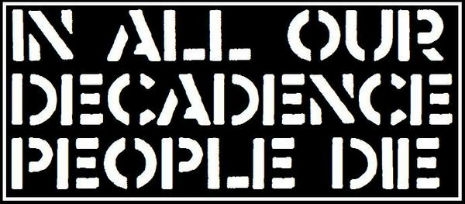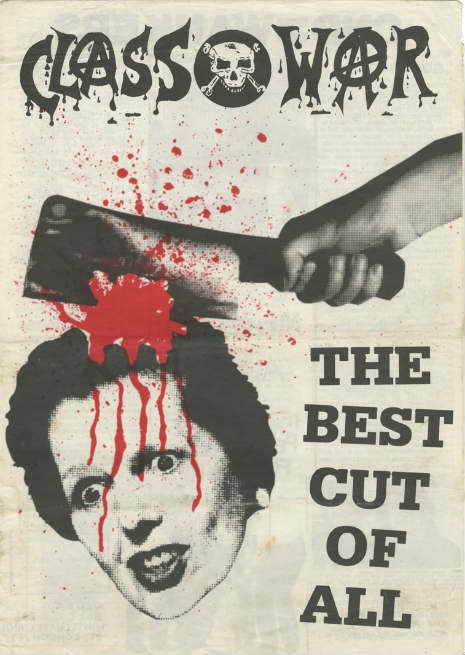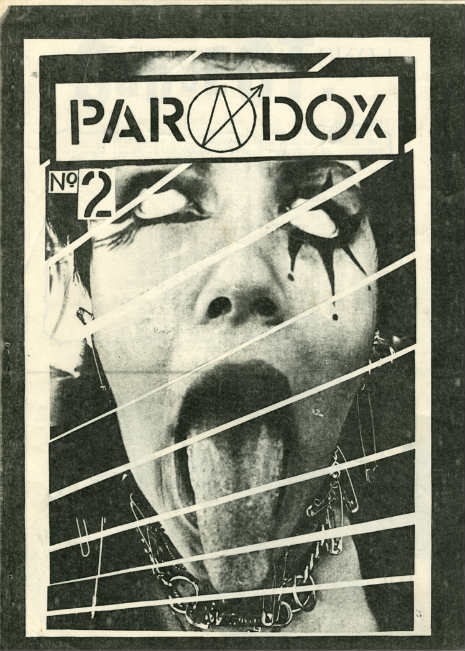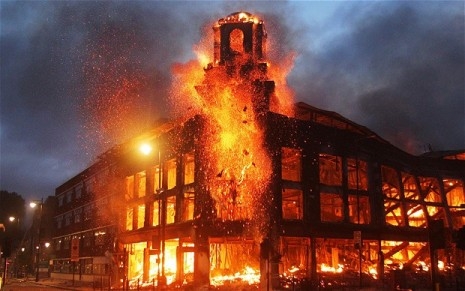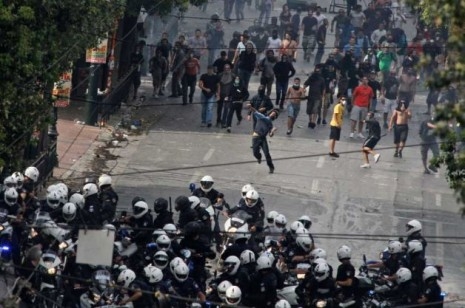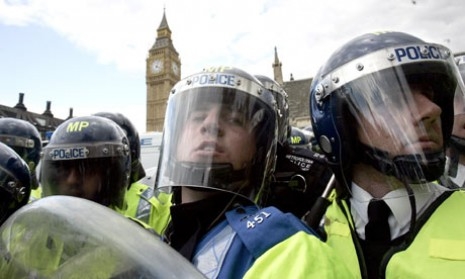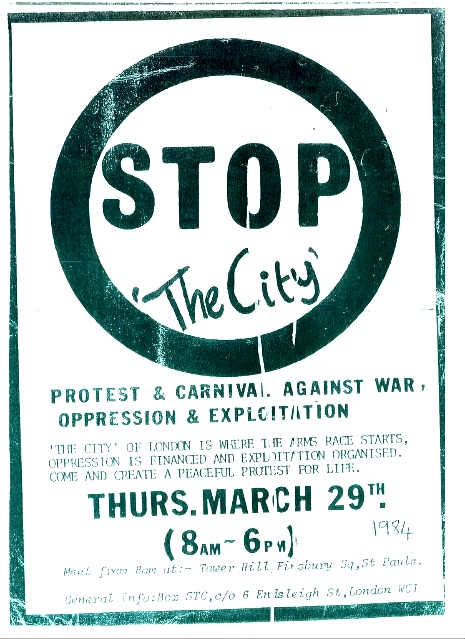
The other day, whilst looking for something else in the garage, I happened across some old photographs taken by me in 1984 during a major demonstration that I participated in, in London, called “Stop The City.” The idea, for what was described as a “Carnival Against War, Oppression and Destruction,” was to put enough bodies in the way to effectively cut off the routes whereby the bankers and stock brokers would get to work, block the entrances to the office buildings themselves and stop business activity in “The City” (as London’s financial district is known) for a day.
The 1984 demo that I was at was the second such “Stop the City” event. The first had taken place six months before, but the second demonstration was a lot bigger. I don’t know exactly who was behind it, or organized it, but certainly the vast majority of the young people taking part could have been described as “Crass punks” or anarchists. I heard of it via my friend Ron, who was at one point in a punk band either called “The Living Legends” or “The Apostles” with Ian Bone of Class War infamy. Class War, as well as London Greenpeace, were certainly involved in getting out the troops. There were many anti-nuclear protesters and an anti-vivisection contingent which formed a significant subset of the demo. An item on the excellent Kill Your Pet Puppy blog posted by editor Al Puppy reads:
What I can add is that the idea for Stop the City came from Dave Morris – of McLibel trial fame, longest trial in English legal history – and London Greenpeace. It was organised from a house on Ickburgh Road, Upper Clapton, Hackney. Dave and others (including my future wife Pinki) had been given the house by the GLC so they could organise an anti-nuclear march from Faslane in Scotland to Greenham in Wiltshire.
The tactic to “occupy” London’s financial district was inspired by the heroic anti-nuclear weapons blockade of the RAF Greenham Common by the Greenham Common Women’s Peace Camp.
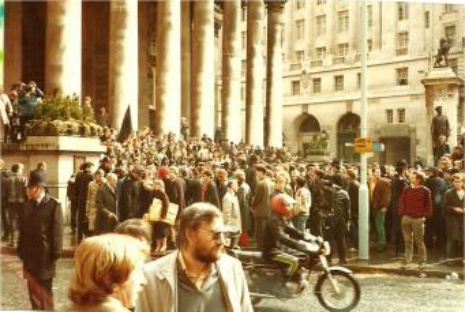
Protesters met at 6am outside one of the underground stations. I got there five minutes early (I am nothing, if not punctual, even for a riot). At first it looked like nobody was going to show up. Then it went from almost no one there, to hundreds and hundreds of people streaming into the area within a matter of just minutes. In France they call uprisings of this nature “manifestations” and that’s what it felt like was happening that morning as the numbers of spiky-haired anarcho-punks and squatter-types arriving in the area grew very, very suddenly. It was an absolutely magical moment to partake in as people seemed to “materialize” in the light London rain that morning. It’s worth pointing out to the (ahem) younger generation that this was long before cell phones, Facebook and Twitter. Most of the people at this demo, I’d wager, didn’t even have land-line telephones because they lived in squats (as I did then). This was basically a word of mouth thing.
For a long time it was just a bunch of young punks milling about, trying to be threatening to stock brokers and bankers and yelling stuff at them. The cops had already partially prepared the area and there were crowd control fences everywhere, but they’d underestimated the size of the crowd. The metropolitan police were badly out-numbered for the first few hours of the protest as the lobbies of several office buildings were occupied and a general “mild” ruckus was caused.
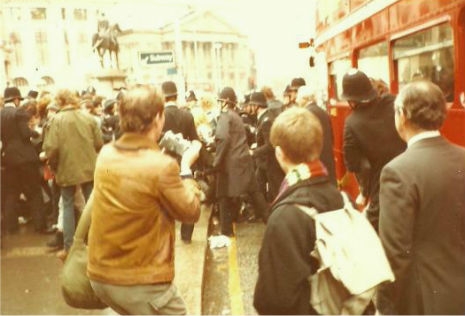
It got pretty nuts pretty fast when a hot-headed stockbroker-type actually decided to try to run some of the protesters over with his car, which was then upended by furious onlookers. That’s what ignited the next phase of what happened when a small faction started tossing smoke bombs and balloons filled with paint. A friend of mine chucked a trash can through a bank window. I spray-painted “Smash Capitalism” on the side of a building. Good times!
At a certain point, hundreds of police reinforcements, including some on horseback, arrived and surrounded the epicenter of the activity and started squeezing about 3000 of us into a pedestrian area near the Stock Exchange. Several military trucks blocked the streets completely. I got stuck in that maneuver and had to stay there for several hours. The tactic the cops used to neutralize and disperse the rioters was pretty clever, or at least it worked: The street grid made it easy for them to herd perhaps as many as 25% of the protesters into this cordoned-off area which they surrounded with metal fences and a line of Old Bill standing shoulder to shoulder staring defiantly into the protester’s eyes as they moved them tighter and tighter together. Several people on my side of the barricades covered the police officers and their horses with “Silly String.” (There was a LOT of “Silly String” around that day). After five or six hours, everyone who had been squeezed into that spot really had to pee.
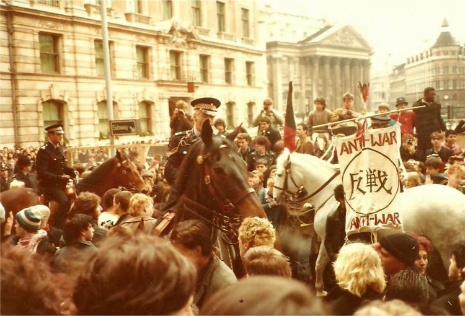
After they were able to disperse much of the crowd outside of this area, they started to let people out a few at a time. A long line of London bobbies brandishing truncheons made sure everyone kept moving along a narrow path cut via the crowd control barricades. Gagging for a piss, I, like my wilted anarchist comrades, was only too happy to wuss out without much of a fight to seek out the nearest pub for a slash.
Revolutionary fervor has its limits when nature has been calling for hours on end and keeps getting a busy signal…
Stop the City was one of those mythical events that if you weren’t there it’s almost as if it never happened. I saw little major coverage in the London newspapers the next day. Only The Evening Standard, The Times and Sounds really covered it, if memory serves and it simply disappeared into the mists of history. There’s hardly anything on the Internet about it, but when you do see it referred to—and I stress that this is rare—it’s usually in the context of how the “Stop The City” demos were, historically speaking, the very first major anti-globalism/anti-capitalism demonstrations, and the precursor to the Poll Tax Riots of 1990, the Battle in Seattle demonstrations of 1999 and the London Carnival Against Capitalism that same year. As those events, in turn, are referred to as being the precursors to Occupy Wall Street, then Stop The City would be the granddaddy of them all. Still, it doesn’t even have a proper Wikipedia entry, just a couple of Flickr slide shows.
I can’t recall how many people were there over twenty-five years-ago, but I do recall that a pregnant friend of mine who did not attend STC told me that BBC radio reported all day long that there were approximately 12,000 demonstrators in the City, but then late in the afternoon they changed their tune and said there were but 3000 protesters. I think it was certainly closer to the original, higher number as there were close to 3000 of us trapped like sardines in the cordoned-off area alone.
Here’s one of the fullest accounts I was able to find of Stop the City, on the LibCom website:
The idea of the “Stop The City” (STC) demonstrations was hatched by three London anarchists at a party in the early eighties. At around the same time people in Australia and America had had the same brainwave. The plan was to bring together the radical end of the peace - ecology - “third world” - and anarchist movements to attack the root cause of all their problems - Capital - by attacking the heart of finance. It took a lot of work to promote the idea of STC and then hold together an uneasy alliance of radical liberals and anarchists. The main problem was the issue of “violence” - many pacifists were worried that people might defend themselves against police attacks/arrests and buildings could be damaged by “violence (sic) against property”. Pat Arrowsmith, veteran CND (Campaign for Nuclear Disarmament) labourite did her best to successfully sabotage CND involvement.
Police freaked
The police were freaked out by the idea of an organised demo which wouldn’t consult/inform them - very rare in modern Britain. They repeatedly tried to contact the organisers and on one occasion two plain clothed senior cops turned up to a London anarchist meeting pleading to meet with people only to be met by an angry silence and sent away.On the day of the first STC the phone of one of the main organisers was ‘mysteriously‘ cut off, and on the night before a large number of riot cops stormed the ‘peace centre’ near the Angel in Islington (a large anarcho-pacifist squat where many of the demonstrators were crashing, searching for weapons - none were found).
Several Stop The Cities were held in London and caused a lot of disruption in the square mile - the first caused and estimated £100 million losses. A number of ‘Stop Business as usual’ demos also occurred Numbers involved ranged from 3,000 in the first STC, dwindling to 500 odd at the last one as energy and enthusiasm were sapped by arrests, greater police sus, etc.
Repression
A repressive Public Order Act was passed in response to STC and the activities of hunt saboteurs, etc. Close to 1,000 arrests were also made over an 18 month period.

Comedian David Baddiel was apparently in the same penned-off pedestrian area with me. He told The Mirror on April 9th, 1997:
“I used to joke: ‘At least when you’re being beaten up by skinheads, you can pray that the police turn up. But when you’re being beaten up by police, there’s no point thinking some skinheads will save you’.””
David, then a 19-year-old student with a radically big haircut, had travelled to the City of London to join a Stop The City demonstration run by a fringe anarchist group called Class War.
What followed was an eight-hour encounter with the strong-arm of the law that saw him hurled around a police van and thrown into a crowded cell.
“There were quite a few of those demonstrations in the Eighties,” says David, 32, who was studying English Literature at Kings College, Cambridge.
“There were no proper political motives. The intention was just to cause a disruption. I went along only because I thought it would be a laugh.
“At the time, I had really big hair and everyone else did so I fitted in and looked the part. Basically, the demo was people walking up and down shouting slogans. ”
“But the police tried to get us all into a small pedestrian area off Threadneedle Street where we were bounded in by railings.
“I was up against the railings and thought I was going to get crushed. So I climbed over and tried to get through the police cordon.
“The police wanted to throw me back into the crowd but I said: ‘No, I’m not moving.’ When I said I was going to be crushed they ran me off into their van.
“Inside the van about five of them started throwing me around. I didn’t suffer any serious injury but basically they were beating me up. “One of the policemen put his fist in my face and told me if I caused any more trouble, it would be going through my head. They filled the van with some other people then took us off to the police station.
“We were put in a cell with about 25 other blokes and one toilet in the middle of the floor.
“We were there for hours and I was bursting but I couldn’t face having a pee in front of all these other men just in the middle of the floor.
“Right at the end, after hours in there, the police gave us one polystyrene cup of water to drink - between all of us. By the time it got to me, it was just spittle.””
David was accused of trying to lead an aggressive charge and charged with obstructing the police and the highway. But when his case came before a magistrate, he was cleared.
“A young junior barrister took on my case for free. He pointed out that the police evidence contradicted itself and the case was dismissed.

And finally, here’s the description from Punk Torrents of a long out of print documentary film, Stop the City: 1984 made by Mick Duffield and members of Crass that came out in the mid-90s. I had no idea this even existed:
The Stop the City demonstrations of 1983 and 1984 were described as a ‘Carnival Against War, Oppression and Destruction’, in other words protests against the military-financial complex.
Activities that formed part of these events were separate day-long street blockades of the financial district (‘The City’) of London — which supporters of the protest argued are a major centre for profiteering and consequently a root cause of many of the world’s worst problems.
One blockade involved 3,000 people, which succeeded in causing a $100m shortfall on the day according to The Times. Around 1,000 arrests were subsequently made by the police over 18 months.The first demo took place on the 29 September 1983 and involved hundreds of protestors, but six months later on 29 June 1984, thousands brought the City to a standstill. This rare documentary by Mick Duffield and Andy Palmer of Crass offers unique footage of the day’s events. Stop the City is widely regarded as being the precursor of modern protest such as the J18 Carnival Against Capitalism in 1999 and the birth of the Anti-Globalisation movement in the 21st century.
Stop The City in its entirety:
UPDATE: More on Stop the City from History is Made at Night







